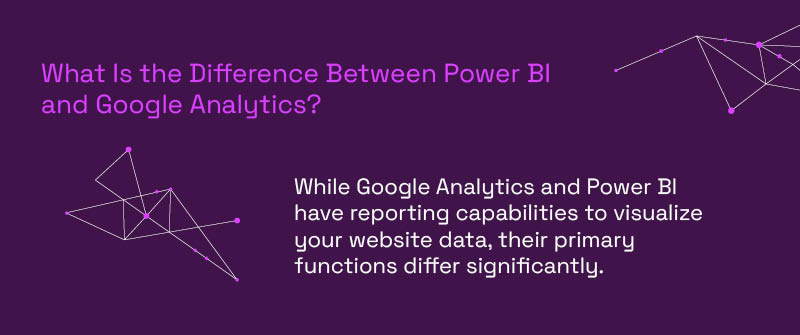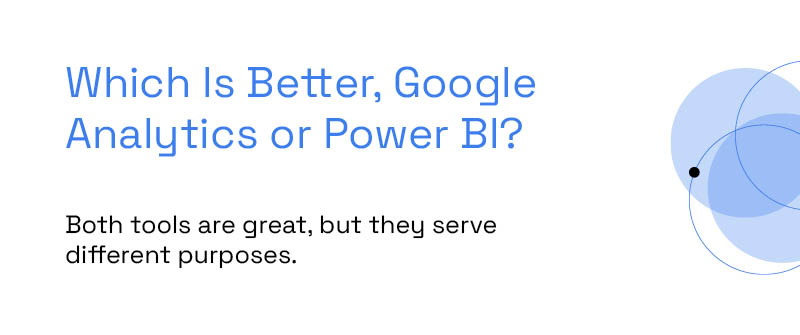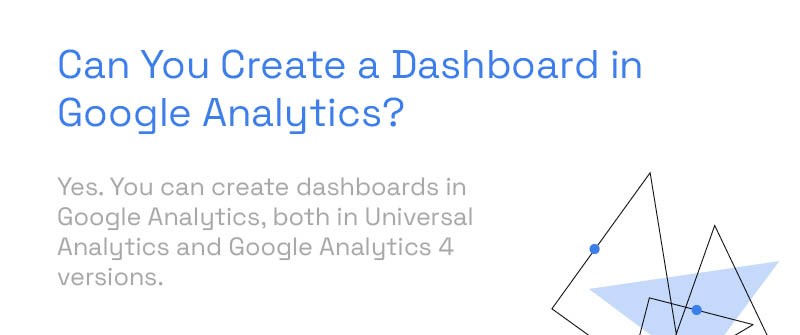
Google Analytics offers standard and exploration reports to help you understand your website performance. However, as the marketing analytics process in your company matures, you likely need to combine and analyze data from Google Analytics and other sources to draw insights from it. This is where Power BI comes into play.
As a Power BI consulting service, we’ll show you that using Power BI with Google Analytics is not just an alternative. It’s the next step in your analytics journey.
What Is Google Analytics in Power BI?
Google Analytics is a platform under the Google Marketing Platform. It collects data from your website and apps and provides reporting features.
Google Analytics in Power BI is a powerful integration that provides an enhanced way of visualizing and interpreting your website traffic data. It goes beyond the capabilities of the Google Analytics reporting features, enabling you to make better business decisions and strategic planning.
You can connect Google Analytics with Power BI by leveraging the built-in Power BI Google Analytics connector. If you need a Power BI Google Analytics tutorial that walks you through connecting Google Analytics to Power BI, be sure to check our other blog on how to get Google Analytics to Power BI.
The Google Analytics Power BI integration allows you to create custom reports and dashboards in Power BI with data from Google Analytics. Moreover, it allows combining with data from other sources. This gives you a more holistic view of your marketing performance. You can better understand how your audience interacts with your website, making it easier to spot trends, patterns, and areas of improvement.

Why Use Power BI With Google Analytics Data?
The reports in Google Analytics help you understand quite a lot of information from various angles. So, why use Power BI with Google Analytics?
Here’s the answer:
You’ll need to understand your customers better as your marketing analytics process matures. That means diving into a ton of customer data, which can be both structured and unstructured, scattered in different places. Google Analytics isn’t going to be the only game in town. You’ll likely need to combine it with data from other sources, like your CRM system and marketing automation platform. And that’s where a business intelligence tool like Power BI online comes in.
Power BI simplifies getting data from multiple sources, performing various analyses on it, and then reporting the results, often in the form of dashboards.
By creating custom reports and dashboards in Power BI, there are many benefits you’ll get, such as:
- You can integrate your Google Analytics data with data from other sources.
- You can create custom metrics and advanced calculations with DAX.
- You can use advanced data visualization and build interactive dashboards.
- Easy sharing and collaboration with stakeholders.
- You can set up alerts to notify you of important changes or trends.
Overall, Google Analytics Power BI dashboards can be a big win for your business. A deep dive into your data can help you make better decisions and optimize your marketing strategy.
What Is the Difference Between Power BI and Google Analytics?
While Google Analytics and Power BI have reporting capabilities to visualize your website data, their primary functions differ significantly.
Let’s discuss each of them one by one.

Google Analytics
Google Analytics helps you measure traffic and engagement across multiple platforms. For websites, it provides extensive insights into visitors, traffic, and content interaction. This is essential for businesses that value their online presence.
Here’s what you can uncover with Google Analytics:
- Visitors. Google Analytics provides data on the number of visitors, unique visitors, time spent on the site, first-time and returning visitors, and more. It also lets you learn visitors’ demographic data, like geographic location, browser, and device used.
- Traffic. This tool reveals how visitors reach your site. Understanding the source of web traffic, including the amount from search engines vs. other referrals, is important. Google Analytics also identifies what keywords that drive traffic, which is crucial for SEO purposes.
- Content. Google Analytics helps understand how visitors interact with your content, such as entry and exit points, page views, and how long they stay.
Please note that these aspects only scratch the surface of Google Analytics’ capabilities. The latest version of Google Analytics, called Google Analytics 4 or GA4, takes these capabilities even further.
Introduced as a future-proof solution for measuring customer journeys across websites and apps, GA4 offers additional features focusing on predictions, customizability, and privacy—marking a significant shift in how web and app properties are tracked.
Power BI
Power BI is a business intelligence (BI) tool by Microsoft.
Unlike Google Analytics, Power BI has data modeling and transformation capabilities.
The Power BI data model is powerful and built to support multi-system linkage. It allows you to explore complex data relationships and uncover deeper insights. Its strength lies in its capacity to link data from multiple sources, including Google Analytics. This allows you to get a whole picture of your business performance, not just limited to website traffic and interaction.
With Power BI, you can clean and shape your data before analysis. Through Power Query, the best-in-class ETL tool, preparing data for in-depth analysis is easy. This process helps ensure that the data used in reports and dashboards is accurate, relevant, and structured appropriately.
Which Is Better, Google Analytics or Power BI?
Both tools are great, but they serve different purposes.
New digital marketers will likely get their first exposure to analytics through Google Analytics. This tool is great if you want to understand only your website performance.
However, as the marketing analytics process in your organization grows, you’ll need more than just website data. Bringing your Google Analytics data to an external tool like Power BI, Tableau, or Looker Studio (formerly Google Data Studio) will be a better choice for your reporting solution.
Hopefully, this explanation also answers if you are wondering about Google Analytics vs. Power BI vs. Google Data Studio or Google Analytics vs. Tableau vs. Power BI.

More FAQs about Google Analytics
You may still have questions related to Google Analytics and Power BI. In this section, we answer some common questions asked by users.
Does Google Analytics Have API?
Yes, Google Analytics has APIs.
In fact, it has several APIs that allow users to access and interact with their Google Analytics data programmatically.
For example, if you use Google Analytics 4, you can use Google Analytics Data API to access report data and Google Analytics Admin API for account configuration. There is also Google Analytics User Deletion API that allows you to process deletions of data associated with a given user identifier.
What Is the Google Analytics API?
The Google Analytics API provides programmatic methods that allow you to access data in Google Analytics. This includes the configuration data of your Google Analytics account and the actual report data.
For analytics purposes, Google has these two main APIs for different versions of Google Analytics:
- Google Analytics Reporting API: This API provides programmatic methods to access report data in Google Analytics, specifically for Universal Analytics properties.
- Google Analytics Data API: This API is used to access the new reporting features for Google Analytics 4 properties. This API currently provides features available in alpha and beta versions.
These analytics APIs allow you to interact with Google Analytics data outside of the user interface and build your own applications that integrate with Google Analytics.
It’s also important to note that Power BI uses these analytics APIs through its connector to pull data into Power BI. If your Power BI Google Analytics connector is not working, it could be due to API limits. Or there may be an issue with your credentials, data source, or filter. Start by checking for API limitations. If that’s the problem, consider upgrading to Analytics Premium.

How to Use Google Analytics API
To start using it, you must first enable the specific API you wish to use.
Let’s say you want to use Google Analytics Data API for accessing your GA4 data. In this case, you can follow Google’s API quickstart guide to enable and configure the API.
After setting up the API, you can start retrieving data. This can be done using various programming languages like Python, Java, and PHP.
Can You Create a Dashboard in Google Analytics
Yes. You can create dashboards in Google Analytics, both in Universal Analytics and Google Analytics 4 versions.
It’s important to note that Dashboards in Google Analytics 4 are called Overview Reports. They serve as a central hub for monitoring and analyzing key metrics and data points related to your website. These reports summarize data about a topic, allowing you to see all the important metrics you need from your data at a glance.
If you need more advanced or dynamic data visualization tools or data integration from multiple sources, external tools like Power BI can be utilized. This allows for more complex data analysis and reporting than what’s available directly in Google Analytics.
While Google Analytics provides great insights, combining it with a tool like Power BI can unlock even more potential from your data.

Take Your Marketing Analytics to the Next Level With P3 Adaptive!
Navigating the complex world of marketing data analytics can be challenging. It often requires a unique blend, a perfect combination of analytical and technical skills. That’s where our consulting services come in.
At P3 Adaptive, we specialize in simplifying complex data problems. We’ll help you uncover valuable insights from your Google Analytics with Power BI. Plus, we can expedite both the implementation and success of your analytics, enabling you to make data-driven decisions to maximize your results.
Ready to boost your marketing efforts? Contact P3 Adaptive today. Let’s start this journey together and unlock the true potential of your data!
Get in touch with a P3 team member